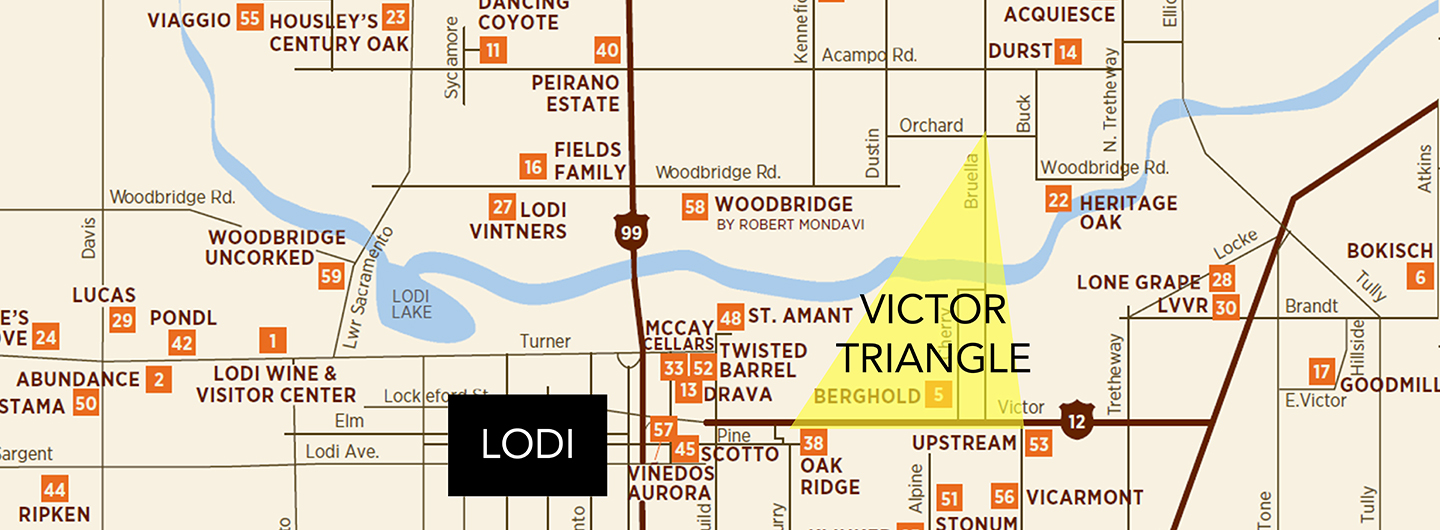Jon’s July 9, 2019 Update
During January, February and March, our main concern is for that Goldilocks amount of rain: enough to carry us through the growing season and avoid drought, but without flooding.
This was the year relentless atmospheric rivers caused the Russian River to flood, damaging nearby wineries, but somehow maintaining a northwest flow that kept west of Lodi.
By the end of March, the Victor North weather station, which serves as the main source for our data, (see far below for the location) recorded a seasonal rain accumulation of 18.39 inches. This was more than an inch above the recent average.
We felt it, too, as the vineyard access roads turned to butter and made it more challenging to finish up pruning.
Markus also had a chance to “personally examine” the snow pack (with his skis) up at Bear Valley and found they had received 449 inches (37 feet) of snow, with Squaw Valley higher up-slope having received 618 inches (51 feet)!

Temperature-wise, we did have a fairly warm January – even hitting 70.2 degrees F on the 19th – before cooling to somewhat under average during much of February. There were only 8 non-rainy days in all of February, and two of those days at the end of the month brought a productive atmospheric river. There were also 7 days of frost.
The cold February delayed budbreak from recent averages, completing during March, very similar to what we observed for 2018.
April and May
While vine shoots are short and fragile, usually during the entire month of April, we are on frost and hail watch. For frost, we have alarms to wake us in the middle of the night to turn on overhead sprinklers for particularly-susceptible vineyard blocks, such as the Borra Vineyards Gill Creek Ranch Sunken Block, right up near the Mokelumne River.
For hail… Well, we just pray and watch the doppler:

On Tuesday, April 2, mid-afternoon, with vine shoots a few inches long, the Storm Radar iPhone app alerted us to a storm cell approaching from the west. It hailed briefly in town, as you can see above, then we watched from a distance as it passed straight over our main vineyard sources.
Over half an inch (0.51) of rain fell out of the sky in Victor that afternoon, but, thank God, there were no reports of any damage from our vineyard sources or anyone we knew.
(On April 7, 2015, there had been substantial damage in many Lodi vineyards from hail. I opened the sliding door of my house to see what seemed like a huge box of white marbles being dumped all at once on my vines, shredding them. Those memories stay with you.)
Fortunately, we made it through April with almost textbook-perfect growing conditions: temperatures up into the upper 70’s and low 80’s, with a few days of light rain, and no frost or hail.
We all thought we were in the clear and ready for May to continue the fantastic weather as we prepared for ZinFest mid-month.
Then the jetstream went all “Mossby” on us…

As you can see above, a low-pressure system dropped straight down the west coast and brought fairly-unusual rain for this time of year. (This pattern of lows herniating way down southward has become known as a series of Mossby waves, which you can read about under “More-Extreme Weather” way below.)
It rained for eight days in a row from the 15th through the 22nd, dropping 1.89 inches, with an inch of that coming right down on top of ZinFest weekend, soaking all the die-hard Lodi wine fans. They were real troopers.
This happened while all the white wine varieties were finishing up bloom and most reds were in some stage of bloom. We therefore became very concerned about fruit-set and what clusters might look like.
Typically, rain can disrupt pollination, causing some flowers to not pollinate and just drop off as “misses”, or causing sub-optimal pollination, resulting in small “shot-berries” or a cluster looking like a bunch of “hens and chicks.”
You can see how rainfall accumulated very nicely during the year in these two charts:


The February rains had given us a boost over seasonal averages, but then that oddball Rossby Low in May kicked us significantly above average, so that we ended the July 1-June 30 rain season with a total of 21.31 inches, compared to 19.9 inches for 2018.
The vineyards did dodge a bullet during that stretch of odd weather in that a rogue thunderstorm literally dumped winter-looking “snow” (really hail) throughout much of North Stockton:


Most Lodi vineyards are north of Stockton, and we didn’t hear any reports of damage.
For cherries, which are a significant part of local agriculture, it was a different, very sad, story:

The early-ripening varieties were experiencing the same perfect growing conditions as our vines, but cherries nearing picking can’t handle much excess moisture. Consequently, as most of our growers who also produce cherries told us, they all split. “It was a disaster,” said a friend who handles quality control for a local processing facility. Cherry buyers checked out of their extended-stay hotels early.
It was announced that 51% of the area’s cherry crop was lost at a value of $61 million.
All those cloudy days naturally slowed vine growth and depressed temperatures. You can see the obvious cooling during May in the chart below:

June
So, June ran hot and cold.
At this point, the vines were happy with the heat and all the water in the ground, sending out longer shoots and laterals that had to be hedged more aggressively. We spent quite a bit of time pulling fruit-zone leaves to open up the canopies to let in light and air to help with ripening and hinder powdery mildew.
The weeds were also happy to come back for a second round of uninvited growth. They had to be whacked back with additional labor.
During the second week, we were hit by a 4-day heat wave, hitting 104.8 degrees F at it’s peak, and causing friends in the Bay Area to post a vast array of fans blowing on cats, things melting, frosty mugs of beer, etc.:

It broke records in the Bay Area (and probably caused some to cave-in and finally buy an A/C unit):

This blast of heat turned our attention up to the snowpack, which had received that May boost to lay down a substantial 203% of normal amount accumulated:
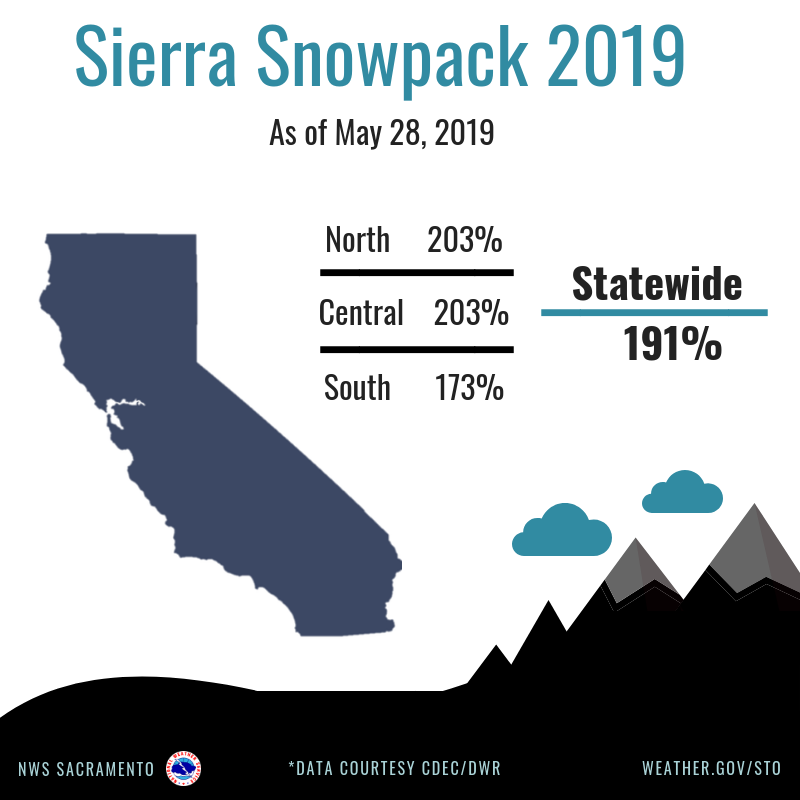
(Note, for the record, that friends of ours were still SKIING in June!)

The Mokelumne River skirts right up to two of our important sources of grapes, and it had already been running strong and cold all season. We knew throwing a bunch of heat on packs of snow could result in flooding like we saw back during most of the growing season for 2017, when Mokelumne Glen Vineyards was pruned by kayak.
We daily kept an eye on releases from the damn up river to be ready to – I don’t know – cry? One winery owner along the river had put up a sandbag barricade and was calling the East Bay Municipal Utility District almost daily to let them know that we’d GREATLY prefer as low a flow as possible, considering one of their reservoirs was at 101% and the nearer one, Camanche, was at 94%.
Somehow, smart minds prevailed and we noticed orders to lower the flow, just as the river was starting to naturally seep through the levees protecting the vineyards:

July
Now here we sit in a relatively-cool patch – mid-80’s – at the start of the second week of July.
Looking at the heat accumulation this season, despite the ups and downs, we’re tracking very similar to last year:
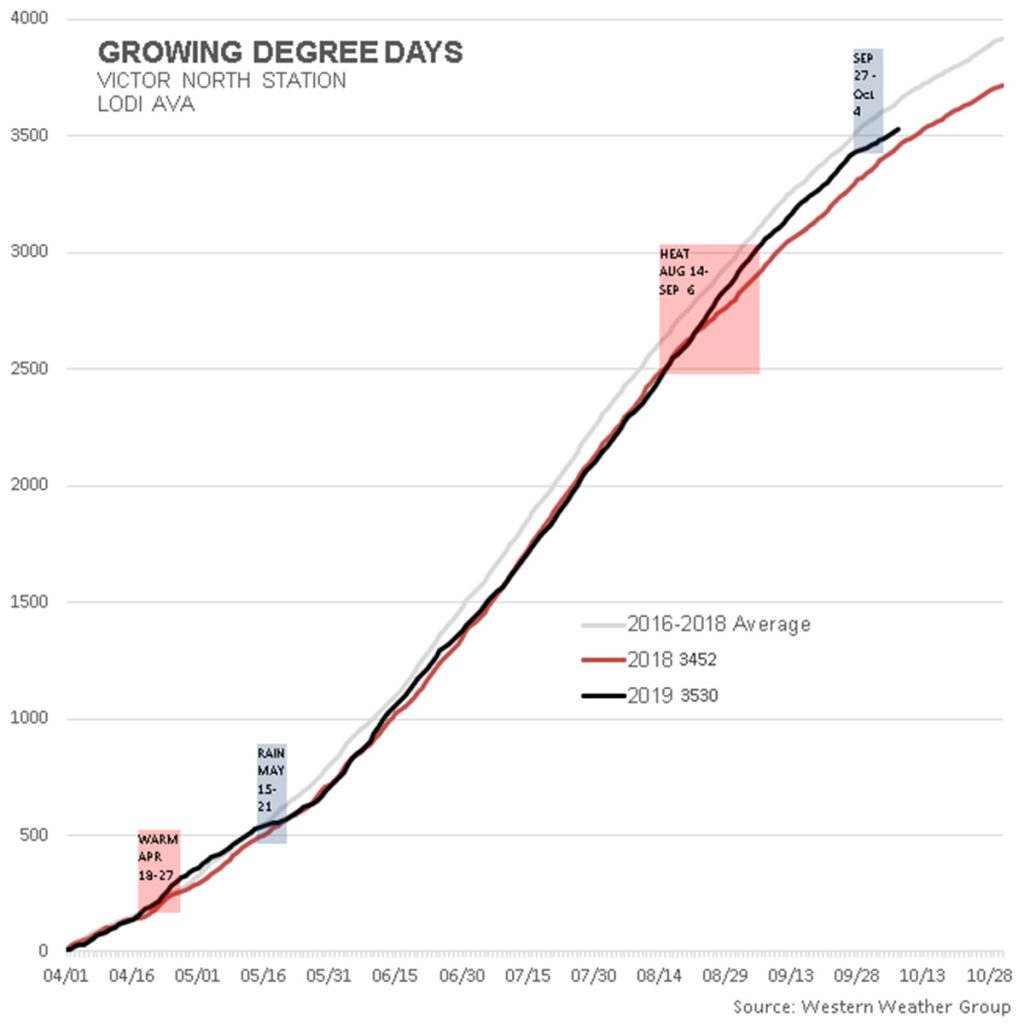
Last year was somewhat cooler than the last few years (our data for Victor North Station only goes back to April of 2016).
As for the rain during fruit-set, it may have actually helped open up otherwise tight clusters by creating misses from shatter.
On social media, we’re starting to see pictures of a few purplish berries in clusters around Lodi. I saw ONE Zinfandel berry that was purple, and Markus saw a few more. Nothing on any other variety yet to be seen, though the whites are a bit harder to notice from a distance. Many varieties are therefore developing at a rate over 10 days later than average.
We are now working with our crews to drop clusters on Petite Sirah, Malbec, Barbera and Merlot in our vineyard sources.
As for what’s to come, I ran this forecast for August-September-October, which indicates that we might be a bit warmer than average in that light-tan bubble that is over half our county, but your never really know for sure:

Honestly, so far, so good!
More-Extreme Weather
NOTE: If you’re not a weather geek, you might not enjoy this part…
I was wondering how we could get these oddball extreme swings in temperatures and rain events, considering that things used to be more steady-Eddy.
I kept seeing mention of “Rossby waves” and dove deeper, finding an excellent 4-minute video that explains things so well that you should just stop reading and watch:
If you don’t have time to watch, I’ll explain it quickly.
This time of year, the northern jetstream usually traversed the upper latitudes in more of a regular circle, with some deflection north or south, influencing high and low pressure systems.
In the last few years, however, due to many factors that may include more rapid melting of arctic sea ice and amount of snowpack in Eastern Siberia, the regular circle of the jetstream has become distorted into widely-oscillating waves, named Rossby waves. There may be between six to eight of these dips southward all the way around the top of the globe:

Each dip brings cold air from the arctic down into lower latitudes, as far south as the Mediterranean Sea, for example. The jetstream correspondingly gathers very hot air from the lower latitudes and pulls it northward, creating a high pressure system of warmer temperatures:

Here you can see hot air being pulled up over Europe:

And, in fact, during the last week of June, this happened:
“For a third straight day, a ferocious heat wave is baking large parts of Europe, and the exceptionally high temperatures are making history. On Friday, June 28, the town of Gallargues-le-Montueux in southern France hit 114.6° F (45.9° C), the hottest temperature ever recorded in the country.” – The Washington Post
For perspective, on June 28, we, here in Victor, had a sub-normal high of only 86.9° F.
Only four weeks later, Europe was hit with another record heat wave.
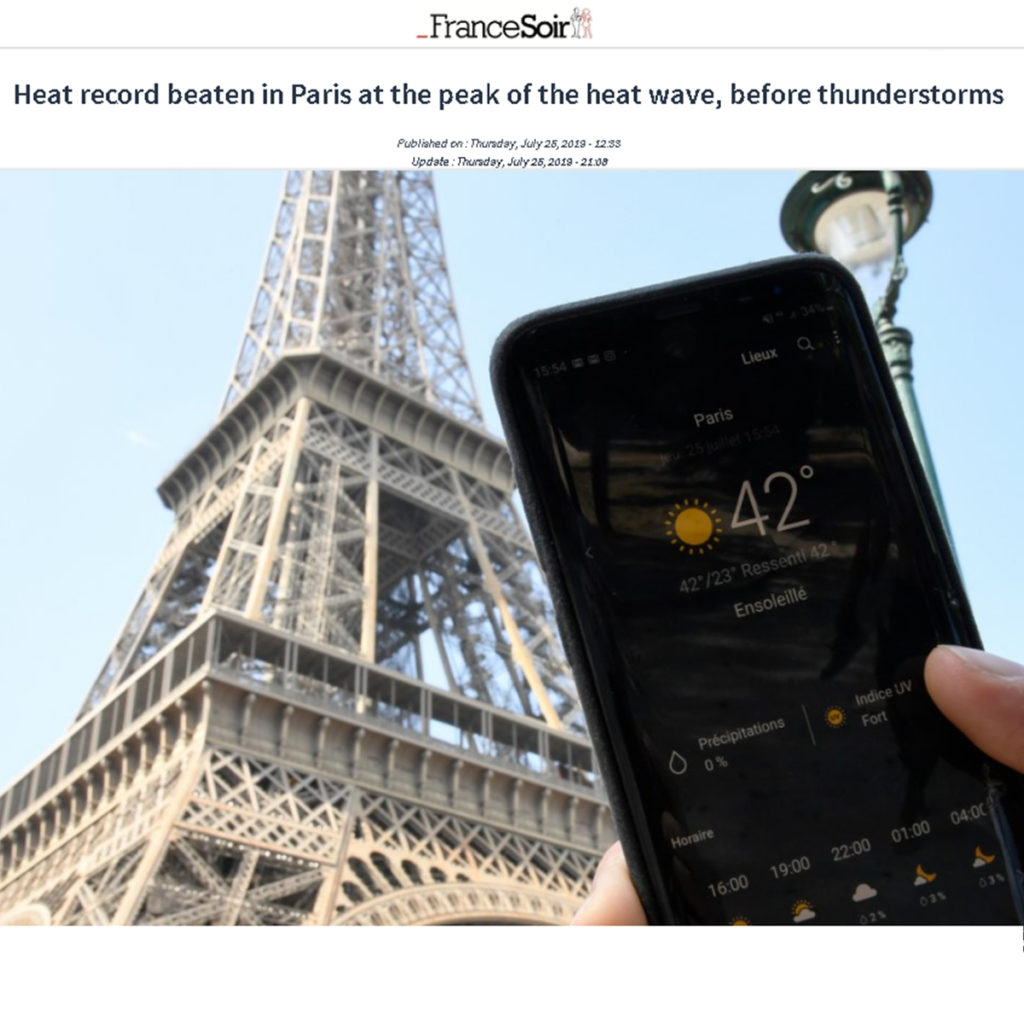
France logged its hottest night ever measured, followed by an all-time record high on July 25 in Paris of 108.6° F (42.6° C), breaking the 70-year-old record of 104.7° F (40.4° C) set in 1947. Near Valence on the Rhône, the temperature reached 98.6° F (37° C). France’s highest temperature that day was observed in Saint-Maur, Ile de France (southeast of Paris), where the mercury rose to 110.4° F (43.6° C).
For reference, Victor hit 100.0° F the same day.

And remember that less than 5% of all European households are air-conditioned.
This heat wave, along with drought, hail, and frost have resulted in a forecast drop of 6% to 13% for yields for the 2019 French harvest.
In the Champagne region, the expectation is that there may be a 20% decline. Bollinger’s cellar master, Gilles Descôtes said, “We were expecting to have 11,500kg/ha [5.1 tons/acre], but with frost in spring, then hail, then storms, and powdery mildew – which affected some of our Chardonnay – and then the heat, we can expect to reach 9,500kg/ha [4.2 tons/acre]. The worst for the quantity was the heat.”
About Victor North Station
The Victor North weather station is located within Katushas’ Vineyard, planted in 1915 and owned by Bedrock Wine Co.
The station is a third of a mile from the source of most of our white wines, Mokelumne Glen Vineyards, and just over a mile north of our winery in the hamlet of Victor, California. Victor is about 3 miles due east of the City of Lodi.
Data is automatically uploaded daily via the Western Weather Group and sponsored by the Lodi Winegrape Commission.
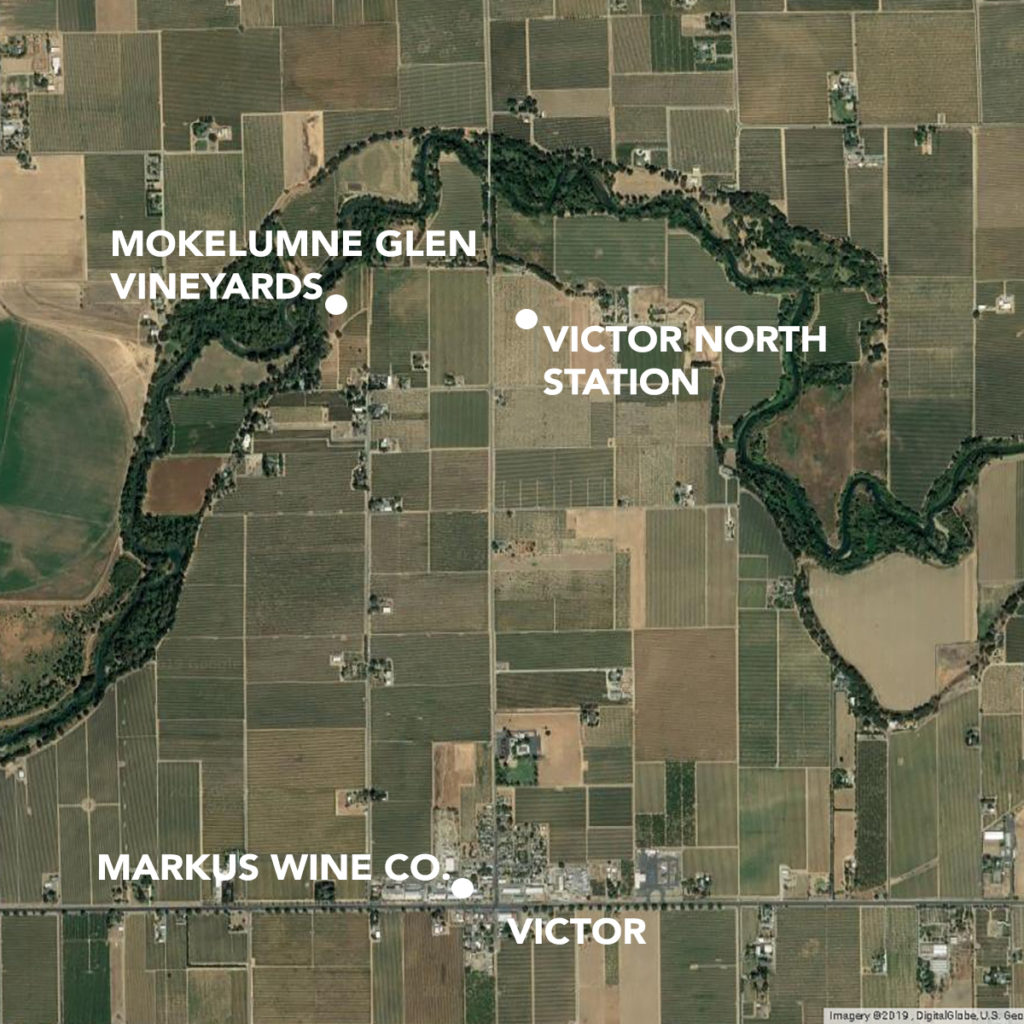
For Wineries
We purposely make extra wine and bottle it as shiners. We offer the wine for sale most of the year. We also source and sell Lodi winegrapes.
Please check out what we have to offer:
BULK & SHINERS GRAPES2019 Vintage Summary
So far, 2019 will be remembered as the year that it rained during ZinFest and bloom.
A cold, rain-soaked February delayed budbreak later into March with timing similar to 2018. April had perfect growing conditions with no frost or hail. During bloom was a streak of 8 days of unusual mid-May rain, dropping 1.89 inches, with an inch of that coming right down on top of ZinFest weekend. Season rainfall was 21.31 inches compared to 19.9 in 2018, and the Central Sierra snowpack hit 203% of average, yet there was no serious flooding of the Mokelumne River.
Growing degree days are a bit ahead of 2018, and that heat, combined with extra soil moisture have resulted in very vigorous vine shoot growth, requiring extra hedging and fruit-zone leaf pulling. We are just entering veraison in Zinfandel, and dropping crop in most varieties to balance the load, which also appears to be similar to 2018. The rain during fruit-set may have actually helped open up otherwise tight clusters by creating misses from shatter. Many varieties are developing at a rate over 10 days later than average. Forecast calls for slightly warmer-than-average conditions during harvest.
(Feel free to cut and paste this summary wherever you like without attribution to us.)
Thanks for reading!

